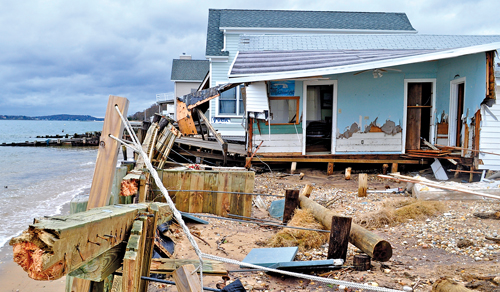How to prepare for the next big storm

It’s never too early for area homeowners to prepare for the next big storm. So hear’s a guide to everything from choosing the right insurance coverage to setting up a generator.
Review your coverage
Atlantic hurricane season officially began June 1 and ends Nov. 30, and the busiest time of the season is just starting, weather officials said. Last season’s superstorm caused $18.75 billion in insured property losses across the Northeast, a figure that does not include damage covered by the National Flood Insurance Program, according to the Insurance Information Institute, an industry-funded nonprofit group.
Now, almost a year since Sandy ravaged the Northeast, many homeowners still find themselves paying for repairs that weren’t covered by insurance.
One of the first things homeowners should do to make sure they’re ready for this storm season is re-examine their policies, said Elizabeth Hanlon of Allstate in Riverhead.
“Understand what your policy covers,” she said.
Standard homeowner insurance policies cover damage due to fire, lightning, hail, explosions and theft, according to local agents. The policies do not cover flood damage, a major component of the most recent storm.
Special Report: Remembering the ‘L.I. Express hurricane of 1938’
Instead, all primary flood policies are underwritten through the federal government’s National Flood Insurance Program, managed by the Federal Emergency Management Agency, explained Peter Sabat, senior partner at Neefus Stype Agency Inc. in Aquebogue.
A primary flood policy provides up to $250,000 of building coverage and $100,000 of contents coverage, subject to a chosen deductible, Mr. Sabat said.
A homeowner considering flood coverage should realize that there is a 30-day waiting period for a policy to take effect, unless a mortgage closing is involved, he said. So people who find themselves scrambling for generators, water and batteries in the run-up to a storm won’t also be able to quickly buy some flood insurance.
Neither standard homeowners policies nor the National Flood Insurance Program, however, cover flood damage to sewer systems, which can cause raw sewage to back up into homes. Ms. Hanlon recommends that homeowners who have experienced such problems before purchase sewer backup coverage as a separate policy or as an addition to the standard policy.
Another potential consideration for homeowners is that if a home is badly damaged in a storm, repairs or rebuilding will have to adhere to updated building codes. Standard insurance policies don’t take into account the increased costs usually associated with conforming to revised codes, Ms. Hanlon said. For example, an older house may need to meet updated electrical codes, she said. Customers can purchase what’s called an ordinance or law endorsement, another add-on, to cover the costs of updating to meet new requirements.
And residents shouldn’t forget to consider contents of the home.
Mr. Sabat and Ms. Hanlon both recommend that homeowners inventory their possessions, everything from televisions to jewelry and furniture, and write down all purchase prices, dates, serial numbers and receipts, according to the Insurance Information Institute website, iii.org. There are now several apps available for smartphones that can help homeowners in this task. Both iii.org and allstate.com provide links to these applications.
Ms. Hanlon said homeowners could also simply throw receipts in a fireproof box, as long as they do so consistently after purchases.
Stock up on essentials
With the right insurance in place, homeowners should head to the hardware store before the last minute to get storm necessities and the proper tools and materials for post-storm cleanup (and to avoid lines at the stores!)
Aside from a radio, flashlights and batteries, “the number one priority is the generator,” said Chris McBride, store manager at Carl’s Equipment and Supply Inc. in Riverhead. Most homes in the area need around 5,500 watts he said.
Make sure a generator is kept outside but protected from the elements, he said, and that the muffler is not facing the inside of the house — the exhaust can be deadly.
For gasoline-powered generators, homeowners should keep at least 10 gallons of gas on hand, he said.
Dead trees or limbs should be trimmed before the storm, to help minimize wind damage, said Chris Mohr, owner of Chris Mohr landscaping in Cutchogue.
“Trees are the most dangerous thing during a hurricane,” he said.
You also want to put away or tie down anything, from lawn furniture to barbecues, that could get swept up and blown into the home, he said.
After it’s over
Once the storm has passed, assess the home for any damage, but be sure to call an insurance provider before making any repairs, Ms. Hanlon, the insurance agent, said.
“You’ve got to know the steps you need to take when making a claim,” she said. “You don’t just start fixing things.”
You can make emergency repairs to prevent further damage, such as removing a tree from a home, she said. But homeowners should call insurance providers for an assessment right away. People who took to fixing things immediately after Sandy sometimes found they got less money from their claims than they might have, she said.
When it comes to the yard, water anything that may have been hit by salt water, keeping in mind that salt spray can make its way inland in high winds, Mr. Mohr said.
“The salt water kills the roots, he said.
He recommends applying gypsum, which draws out the salt, “and you may have to use it a couple of times,” he said.
White pines are very vulnerable to damage from salt spray, he said. Try to rinse off the spray as soon as possible to prevent browning. Often, the spray has only hit the needles and not the roots, so the tree can be saved – but it may take up to a year to see improvement, he said.








